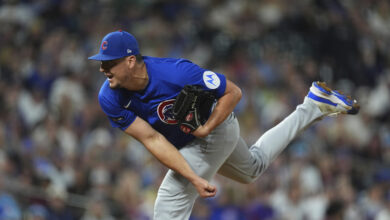
Looking at Dansby Swanson’s Awful Luck, Potential Impact of Torpedo Bat
One look at Dansby Swanson‘s .169/.222/.349 slash line is enough to tell an undiscerning observer everything they need to know about the shortstop. They believe he’s at least 38% worse than the average player, as his 62 wRC+ indicates. But a look under the hood presents a lot of conflicting evidence and a great deal of optimism for a quick offensive turnaround.
First up is Swanson’s .179 batting average on balls in play, a mark nearly 130 points below his career average coming into this season. That tells us he’s been disproportionately impacted by bad luck, especially given his career-best 92.1 mph exit velocity. Typically in the 89-90 mph range, Swanson is squaring the ball up much better (32.8%, 88th percentile) than ever before and getting less to show for it.
According to Statcast’s hit probability breakdown, balls hit 89-90 mph should produce a .187 batting average. Does anyone else think of Snoop Dogg and/or Dr. Dre when reading that? Anyway, balls him at 92 mph should produce a .242 average. So Swanson is missing out on at least 70 points in there, but the whole thing about averages is that not every figure is the same.
Swanson has put 18 balls in play at 100.3 mph or higher, only 10 of which have gone for hits. Wait, isn’t a .444 average really freaking good? Sure, but not when the average 104.2 mph EV on those balls should net about 100 more points. Swanson’s 52.5% hard-hit rate leads the Cubs and his EV is second only to Seiya Suzuki (92.5 mph), yet his results continue to trend in the wrong direction.
The enigma continues when we look at bat speed, where Swanson’s 71.4 mph average is sixth on the team and down just slightly from each of the last two seasons. Bat speed has approximately six times as much influence on EV as pitch speed (a coefficient of 1.2 vs. 0.2), so you wouldn’t expect to see harder hits with slower swings even if Swanson is facing higher velocities. That brings us back to the squared-up percentage, as hitting the ball flush allows for maximum efficiency of power transfer.
If you’ve stayed with me this far, congratulations. Now let’s see if we can bring this thing in for a landing.
After sifting through all the data, it looks as though Swanson has drastically increased his launch angle, whether intentionally or as a byproduct of some other change. We know he’s not selling out for bat speed, so it’s not that. The Marquee broadcasts have noted more than once that his launch angle is way up this season, sitting at 21.6% against a previous career high of 15.7% in 2022. Hitting the ball hard in the air should be a good thing, but the drawback for Swanson appears to be more weak hits.
His fly balls are up to 51.7% against a career 36.5% mark and his infield fly rate of 16.1% is nearly double what he’s seen in the past. The thing I keep circling back to is that maybe something about the new torpedo bat he’s using has caused him to dump the barrel more than before. You might think shifting more mass away from the end of the bat would prevent that, but maybe it messes with the bat’s moment of inertia (MOI) to a degree we can’t discern without using a pendulum to measure the period of oscillation.
Technically speaking, MOI is the quantitative measure of the rotational inertia of a body, the opposition that body exhibits to having its speed of rotation about an axis altered by the application of torque. Put more simply, it’s the bat’s swing weight. Just because bats may technically weigh the same does not mean they swing the same, and it’s entirely possible that Swanson’s torpedo is having more deleterious effects on the balls he doesn’t square up.
The purpose of the bat’s design is to place more mass in the spot where a given hitter makes contact most often, which is pretty easy to understand. But my contention from the time I first heard about them is that missing the fatter sweet spot means getting markedly worse results, particularly toward the end of the bat from which that mass was shifted. There are also ripple effects from changing the configuration of a piece of equipment you’ve used your whole life.
Interestingly enough, Jazz Chisholm Jr. (20.8 launch angle to 11.6 career) and Anthony Volpe (14.9 to 11.1) have also seen big LA increases with huge improvements in barrel and squared-up marks. Both have also seen huge jumps in their fly ball rates, with a corresponding drop in BABIP. Before we go calling this very limited sample a trend, we should note that Nico Hoerner has seen more or less opposite results from this trio.
Still, I think it’s worth keeping an eye on. The initial buzz about torpedo bats was that they should be banned because they’re like a cheat code, but I’m wondering whether they may be doing at least as much harm to the hitters who are swinging them. It’s still very early and there’s more than enough time for some of this aberrant data to come out in the wash, so let’s see where it goes with a bigger sample.
Regardless of what bat he’s using, it stands to reason that Swanson’s luck will turn at some point very soon. If he keeps hitting the ball hard, good things are bound to happen. Right?

